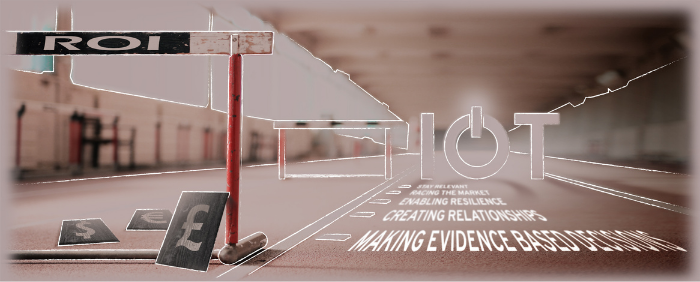Connected Internet of Things (IoT) products can help to enable more sustainable outcomes by measuring use, driving behaviour change and enabling new ‘circular’ business models for longer use and re-use. But as for many sustainable investments the ROI doesn’t always compare to more conventional innovation investments in your pipeline both due to the technology involved and the different revenue profile of the business models that it enables. In the face of this arithmetic, how can leaders justify the investment?
I’m often asked: “how can other corporate innovators successfully develop IoT enabled products when the ROI isn’t there on day 1?” Here are the most compelling reasons I’ve heard from leaders that have succeeded in this space.
1. Staying relevant
Customers are changing – as are their expectations. Increasingly consumers, especially in Gen X and Y, don’t see a divide between physical and digital products. They want an “omni experience”, meaning that they can communicate, connect and operate the product seamlessly between the actual and virtual. But its not just “millennials”, look at how the pandemic has accelerated digital adoption in older age groups too. Brands need to adapt with these changing demographics and expectations or risk losing relevance in the future.
Consider the humble notebook. A few years ago you might have though that digital would kill off paper notebooks. But instead we’re seeing people work seamlessly between physical and digital mediums. One corporate leader I know summed it up nicely: “Younger people don’t see the divide, they just use what’s best for them. Become the platform, not just a product, and you open the door to new demographics”.
2. Creating relationships
Producing a connected product requires a serious mindset change – from “ship and forget” to “relationship management”. And that means switching from a “make and sell” organisation to a service culture that embraces ongoing interactions with customers.
This is a challenge for many organisations, but it also creates many new opportunities. Particularly for marketing, brand loyalty and customer insights. Your connected product gives you direct access to your customer – instantly allowing you to offer additional benefits or related products. By nurturing that relationship and improving their experience, you also have an opportunity to build unparalleled brand loyalty, resulting in a longer customer life cycle and repeat sales. Plus the data about every interaction gives you immediate and invaluable insights into their needs (and importantly for a more sustainable economy, what they really don’t need) – and those of their peers.
3. Making evidence-based decisions
With this data you can make much more informed decisions. You can base your product development – new and existing – on what people really do (and not just what they say they do). As one customer said to me: “Our [connected product] provides us with hard data allowing future product development decisions (for both conventional and smart products) to be based on evidence and not the judgements of HIPPOs (the Highest Paid People’s Opinions).”
Think of the data you collect as part of an ongoing experiment. It can be easy to get lost in the overwhelming volume of numbers and how to value these. Instead focus on questions you need to answer to make better decisions for you, your customers and the planet and then design the product, the business model and your data strategy accordingly.
4. Enabling resilience
A trend we saw in our work during the pandemic has been improving remote product installation and servicing. While social contact has been challenging, the direct (but remote) contact with customers enabled by connected products has distinct advantages.
Connected products allow you to launch earlier, giving yourself a chance to test and optimise in the market – then upgrade software or functionality during the product life cycle. You can perform diagnostics and preventative maintenance at a distance, meaning it’s much more convenient and cheaper – and less unnecessary waste from customers unprepared to wait for a ‘fix’. But more significantly, it enables rapid adaptation to changing circumstances. And in my experience, that’s key to successful, enduring innovation and ultimately a more resilient business model.
5. Racing the market
There’s an evolutionary theory that says that unless you continue to adapt, you’ll get left behind. For a species, that could mean extinction. It’s called the Red Queen Race after the Red Queen’s advice to Alice in Lewis Carroll’s Through the Looking Glass:
“Now, here, you see, it takes all the running you can do, to keep in the same place. If you want to get somewhere else, you must run at least as twice as fast as that!”
A customer of mine shared: “This is an investment we need to be ‘on the train’ and ensure we have an option for digital innovation in the future. While we can’t foresee all the benefits in advance, we know that if we don’t make this investment, we’ll be left behind.”
The big BUT!
One of the things I enjoy most is finding the new business models and consumer experiences that IOT technologies can unlock for today’s brands – and often we can show how to deliver clear ROI. However, every business is different and sometimes it will take longer. But if after a diligent and systematic exploration, you’re not comfortable working with the longer-term or non-monetary ROI that IOT investments might require in your innovation portfolio, then the right strategy (and it is a strategic choice) is not to invest in connected products and tofind other approaches to drive the benefits above for your business.
Need help?
Are there other motivations to driving IoT investments you’ve found to be important? I’d love to hear them in the comments.
Alternatively, if you would like to explore how these factors might impact your own situation let’s chat! You can reach out to me and the Ignite Exponential team at hello@18.170.153.187 or start a conversation via LinkedIn.

